Pest Control
Pest Control
Pests, such as insects and mice can cause enormous damage to library materials.
Insects
Insects pose a serious threat to collections of all types. The environment that is the most damaging to collections—high humidity, poor air circulation, poor housekeeping—is also the most beneficial to insects. If insect damage is evident in a library collection, a careful survey should be conducted using sticky traps to see what types of insects are living in the affected area.
Although pesticides have been traditionally used to control pests, because of the toxicity of pesticides to humans and the potential to damage library collections, use of chemicals has been phased out in favor of Integrated Pest Management (IPM). IPM is a strategy to control pests by eliminating food and water sources for insects and other pest and preventing their access to the building. In other words, PM stresses controlling pests through prevention and good housekeeping.
Controlled freezing and oxygen deprivation have been used as non-toxic means of extermination in cases where pests have gained a foothold.
Make the building inhospitable from the outside
The building itself can be made inhospitable to insects. The following sensible precautions can be taken to reduce and control insect populations:
Do not plant shrubs or trees close to a building, and avoid flowering species.
Remove vines, ivy, and other climbing plants from the walls or roof.
Use wide gravel or paving surrounding the building, ensuring that there are adequate and effective drains to prevent water from entering the structure.
Do not attach lights to buildings, as they will attract flying insects. Insects tend to be attracted by ultraviolet, so lights close to a building should have low ultraviolet output. Lights mounted away from the building should be the mercury-vapor type with a high ultraviolet output.
All garbage and rubbish, including garden and library waste, should be kept in a vermin-proof container away from the building.
Ensure that all roof drains and downspouts are kept clear of debris and in good condition.
Bird and other animal nests should be removed from the building.
Seal all unnecessary holes in the building, and seal and caulk around holes for electrical cables, water pipes, telephone connections, and waste pipes.
Doors and windows should be tight fitting and kept closed at all times, and insect screening constructed of small mesh should cover every opening.
When designing a new building, consider the installation of a revolving door.
Making the building inhospitable from the inside
You can also deter the entrance of insects by using solid, impermeable construction materials such as brick, stone, concrete, and steel. If possible, observe these additional steps:
HVAC (Heating, Ventilation and Air Conditioning) systems create wet and moist areas, and central systems have condensate drains. HVAC systems should be located in a basement area rather than on the roof, and steps should be taken to ensure that there is no standing water and that condensate drains are always clear.
Restrooms, janitors’ closets, and workrooms are sources of water and should be segregated from collection areas.
Condensation on cold water pipes can be avoided by wrapping them with an insulation material.
A quarantine room for the inspection of newly acquired material should be established as close to the goods entrance/loading dock as possible. If incoming materials appear to have some form of insect damage, they should be covered tightly with plastic sheeting and insect sticky traps should be placed under the plastic to check for possible infestation.
Insects love corrugated cardboard as homes and a food source, so old, damaged boxes should be replaced with acid-free, lignin-free boxes.
The building interior should be well maintained and kept clean, as free as possible of the dirt and dust that provide nutrients for insects. Water spills should be immediately mopped up, and care must be taken when washing windows and floors that excess water does not permeate the structure through cracks in the walls or floor.
Keep food consumption and preparation areas away from collection areas—ideally in a separate building. It is preferable that food and drink not be consumed in reader and staff areas, although this is often difficult to control. Spills and food debris should be carefully removed and waste receptacles emptied regularly. Receptions and events involving food and drink should not be held in a reading room or adjacent to a collection area.
Refrigerators and appliances that combine heat and moisture are popular habitats for insects. Areas under and around appliances should be regularly cleaned, and sticky traps placed if necessary.
Inside fittings
If insects have secured a foothold within the building, you can impede their mobility by securing inside doors, especially those leading to areas such as a kitchen or restroom. Consideration might be given to fitting these doors with a weather seal. Other steps to take:
• Cracks in inner walls or the floor should be filled to prevent insects from entering and infesting cavity areas.
• Exhibit cases and special storage cases should be fitted with gaskets to ensure tight-fitting seals.
• Fittings, cases, and room corners should be regularly vacuumed and the vacuum bags checked for insects. Filled vacuum bags should be disposed of outside the building immediately after removal.
Killing insects
A freezer set at or below -20° C (-3° F) can be used to kill insects, which should be exposed for three to four days. Books should be placed in plastic bags and, on removal from the freezer, conditioned under a constant air current from a fan. Freezing is best for occasional infestations, not for routine treatment. A simple chest freezer can be used.
Heat can also be used to kill insects in infested materials. Temperatures of 50°C (120°F) will dry out insect bodies. In tropical areas, infested books can be placed in a metal container wrapped in black plastic and left in direct sunlight for a few hours. Both heat and sunlight can damage collection materials, however.
Because of the possible health risks, insecticides should be used with great care and with full knowledge of the effects on humans and library materials.
Research is being conducted on safe and natural insect repellents, such as compounds made from Neem, which will help to render collections safe. Combined with freezing and heat treatment for small infestations, natural repellents can help to control insects while maintaining an environment safe for humans.
Harmful insects
There are numerous insect types that can be damaging to library and archive materials, and most are found all over the world. Only a few species can be described here, but the discussion can be extrapolated to cover others.
Bed bugs
Bed bugs do not attack books; rather, they use them for cover and transportation. Bed bugs in books put other patrons at risk for infestations in their own homes. Freezing may eliminate bed bugs, but the temperature must be -17 degrees C (0 degrees F) or lower and the materials frozen for at least 4 days.
Cockroaches
These insects seem to be found in every part of the world, and they are tenacious. There are 3,500 types of cockroaches, and they can be divided roughly into urban types, that live exclusively indoors, and outdoor types, that breed and survive outdoors in tropical regions, but which often move indoors when conditions are favorable. The four types associated with damage to library materials: the American cockroach, the Australian cockroach, the Oriental cockroach, and the German cockroach. All four species have large mouth parts and a fondness for starch, thus book cloth and paper are especially vulnerable. Cockroach damage can be recognized by multiple light patches on book cloth surfaces—sometimes down to the thread—and ragged edges on paper leaves. Cockroach droppings can also be detected in the feeding area in the form of pellets.

 The American cockroach (Periplaneta Americana) hides in dark areas during the day and emerges at night. This species regurgitates a sexual attractant in the form of a brown liquid (atar), often seen on library materials. Approximately 40 millimeters in length, it is reddish brown. It is largely an indoor insect, preferring moist, warm areas.
The American cockroach (Periplaneta Americana) hides in dark areas during the day and emerges at night. This species regurgitates a sexual attractant in the form of a brown liquid (atar), often seen on library materials. Approximately 40 millimeters in length, it is reddish brown. It is largely an indoor insect, preferring moist, warm areas.
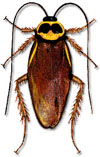 The Australian cockroach (Periplaneta Australsiae), smaller than the American, has light or yellow markings on its thorax and wingtips. Commonly found in moist tropical areas, this insect can live inside.
The Australian cockroach (Periplaneta Australsiae), smaller than the American, has light or yellow markings on its thorax and wingtips. Commonly found in moist tropical areas, this insect can live inside.
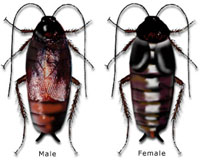 The Oriental cockroach (Blata Orientalis), also known as the water bug, is large and dark brown or black. It prefers cooler moist areas such as drains and inhabits the lower floors of buildings.
The Oriental cockroach (Blata Orientalis), also known as the water bug, is large and dark brown or black. It prefers cooler moist areas such as drains and inhabits the lower floors of buildings.
Silverfish
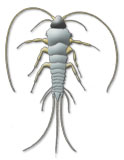 This prefers dark, moist, and moderate to warm conditions. Silverfish tend to graze on the surface of paper and seem to prefer coated paper. Paper that is slightly ragged and thinning at the edges is usually the work of silverfish. Silverfish are ubiquitous, and their small flat shape makes it easy for them to be concealed in cardboard boxes and other items brought into a library.
This prefers dark, moist, and moderate to warm conditions. Silverfish tend to graze on the surface of paper and seem to prefer coated paper. Paper that is slightly ragged and thinning at the edges is usually the work of silverfish. Silverfish are ubiquitous, and their small flat shape makes it easy for them to be concealed in cardboard boxes and other items brought into a library.
Beetles
There are more than a quarter million species of beetles. Some damage books directly by eating paper and binding materials, but it is their larvae that cause the most damage. One type, the dermestidae (hide and carpet beetle), has been known to damage leather bindings.
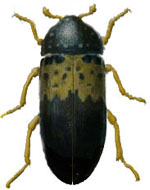 The bacon or larder beetle (Dermestes lardarius) is roughly 7 to 9 millimeters in length. The rear of the body is pale with black spots, while the rest of the body dark brown. The larvae feed on leather bindings and, when fully fed, bore into the text blocks of books to construct a pupation chamber.
The bacon or larder beetle (Dermestes lardarius) is roughly 7 to 9 millimeters in length. The rear of the body is pale with black spots, while the rest of the body dark brown. The larvae feed on leather bindings and, when fully fed, bore into the text blocks of books to construct a pupation chamber.
 The bread or biscuit beetle (Stegobium paniceum) is a small (2 millimeters) reddish brown insect with very small larvae. The larvae feed on starch materials, especially the rice or flour paste used on endsheets and book spines. A borehole of approximately 1 to 2 millimeters runs parallel to the height and width of the book.
The bread or biscuit beetle (Stegobium paniceum) is a small (2 millimeters) reddish brown insect with very small larvae. The larvae feed on starch materials, especially the rice or flour paste used on endsheets and book spines. A borehole of approximately 1 to 2 millimeters runs parallel to the height and width of the book.
 The cigarette beetle (Lasioderma serricorne) is a small, light-brown flying beetle that commonly infests books. The beetle’s larvae are one of the types popularly known as bookworms, with eggs laid on the spine of a book and along the edges. Immediately upon hatching, the larvae tunnel under the binding cover, especially down the spine area. The insect then proceeds to tunnel up to 10 centimeters into the paper text, where it pupates into an adult beetle. The adult leaves a round exit hole, as well as powdered paper on the shelf. One of this beetle’s favorite foods is dried flowers and spices; these should not be brought into the library.
The cigarette beetle (Lasioderma serricorne) is a small, light-brown flying beetle that commonly infests books. The beetle’s larvae are one of the types popularly known as bookworms, with eggs laid on the spine of a book and along the edges. Immediately upon hatching, the larvae tunnel under the binding cover, especially down the spine area. The insect then proceeds to tunnel up to 10 centimeters into the paper text, where it pupates into an adult beetle. The adult leaves a round exit hole, as well as powdered paper on the shelf. One of this beetle’s favorite foods is dried flowers and spices; these should not be brought into the library.
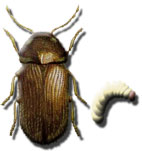 The larvae of the drugstore beetle (Stegobium paniceum) are also often referred to as bookworms. This beetle is found in moist storage areas, and the larvae can actually tunnel all the way through books, from one cover to the other. As with the cigarette beetle, piles of paper powder signal that this insect is active.
The larvae of the drugstore beetle (Stegobium paniceum) are also often referred to as bookworms. This beetle is found in moist storage areas, and the larvae can actually tunnel all the way through books, from one cover to the other. As with the cigarette beetle, piles of paper powder signal that this insect is active.
Termites
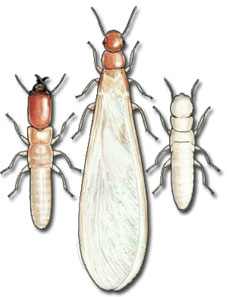 By far the most damaging of all insects are termites, abundant in tropical regions. The damage to all paper-based materials can be catastrophic, in that entire collections can be rendered useless by the severe nature of the attack, often before an infestation problem has been recognized. There are three main types of termites: drywood, dampwood, and subterranean. Termites eat all cellulose materials, including wood, paper, binding cloth, and binding board. Some protection from termites can be given by the building design (use of metal shielding over wooden foundations, painting any exposed wood), but the best remedy is cleanliness, prevention of moisture, and constant vigilance. Termite infestations can usually only be dealt with through the use of pesticides applied by a qualified operator. There has been some success with buried traps that attract subterranean termites.
By far the most damaging of all insects are termites, abundant in tropical regions. The damage to all paper-based materials can be catastrophic, in that entire collections can be rendered useless by the severe nature of the attack, often before an infestation problem has been recognized. There are three main types of termites: drywood, dampwood, and subterranean. Termites eat all cellulose materials, including wood, paper, binding cloth, and binding board. Some protection from termites can be given by the building design (use of metal shielding over wooden foundations, painting any exposed wood), but the best remedy is cleanliness, prevention of moisture, and constant vigilance. Termite infestations can usually only be dealt with through the use of pesticides applied by a qualified operator. There has been some success with buried traps that attract subterranean termites.
Rodents
Rats and mice are the most common rodents librarians are likely to encounter. Rats are difficult to control because they are capable of gnawing through cinder block, lead and aluminum sheeting, wood, plastic, and sheetrock. The most common rats are the Norway rat (Rattus norvegicus) and the roof rat or black rat (Rattus rattus). The house mouse (Mus musculus) is very common and extremely difficult to eradicate entirely. Both rats and mice use paper to make their nests, and many fine books have lost chunks of text through their jagged gnawing. Rodents’ fecal matter and urine are especially damaging. It is generally better to trap rodents than to use a poison that will allow them to crawl into building crevices and die, for rodent carcasses are breeding grounds for insects that also damage library and archival materials.
Keeping food and drink away from collections will help prevent rodent infestations.